IAC News
IAC News No.29, March 2015
Japan Society of Civil Engineers International Activities Center Mar. 2, 2015 IAC News No.29
Contribution to Overseas Infrastructure Development with Japanese Civil Engineering Technology
Asia and Africa have made significant economic growth since the beginning of 21st Century. There are 61 nations which have achieved a high 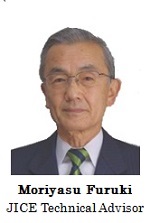 economic growth of more than 5 % real GDP, and out of those nations, 24 are found in Africa, and 14 are in Asia in 2012. These Asian and African nations meanwhile have been unable to develop their infrastructures fast enough to catch up with their economic growth.
economic growth of more than 5 % real GDP, and out of those nations, 24 are found in Africa, and 14 are in Asia in 2012. These Asian and African nations meanwhile have been unable to develop their infrastructures fast enough to catch up with their economic growth.
Here is an example. On the Asian Highway Network Route 1 and Route 9, known as the South and East-West Economic Corridors in the Greater Mekong Subregion respectively, traffic volumes increase 20 to 30 % year by year, that is a similar phenomenon to the one we saw in Japan in the 1960s. It should have gained a broad range of experience by working with the Asian and African countries by providing concessional loans and grants to support their projects, even so, it encounters several technical difficulties carrying out road or bridge constructions locally which often are caused by tropical climates and special soils in those countries.
Japan International Cooperation Agency (JICA) has been putting time and effort to deal with various technical difficulties recently as it has to cover a lot of ground in order to solve the difficulties. Make haste slowly. It will be a great support for the JICA if Japanese professionals such as academic researchers, consultants and contractors who work abroad as “Team Japan” in a large sense, turns their focus on the issues arising due to the tropical environments of those countries and strive to solve them.
In a Team Japan, academic-sector like universities and research institutes and JSCE will have the meaningful roles. They are able to offer professional advice and suggestions on the difficulties and challenges such as increasing durability of cement-stabilized soils, reducing rutting in asphalt pavements, and managing dispersive soils that civil engineers often encounter in road constructions. Then, if the Team Japan builds cooperation with its local counterpart and devises solutions for those challenges together, they will make positive influences on the development of civil engineering industry, the proper operation of ODA programs, and even the expansion of business opportunities for the Japanese construction industry internationally. Furthermore, they will provide young professionals with the valuable opportunities to work in the ODA programs which assist recipient-countries to develop infrastructures and economic activities.
The young professionals will make every effort to accomplish their tasks, struggling with any challenge that they encounter in those programs. They will experience the fast-paced development of countries first-hand and see the contribution of their works to that at the same time. Furthermore, they will become aware of the significant role of civil engineering in society, feeling the sense of pride and contentment welling up in them.
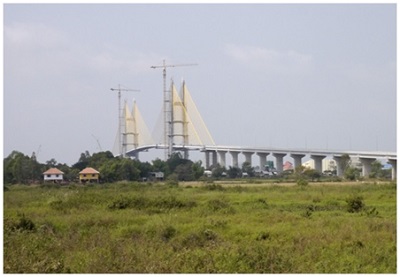 Photo 1. Neak Leoung Bridge in Cambobodia under construciton, which is implemented on an ODA grant-aid. The completion of the bridge will make significant contrituion to the revitalization of economic activities in the area along the South Economic Corridor of the Greater MeKong Subregion. |
Outline of Committee of Infrastructure Planning and Management
Established in August 1966, the Committee of Infrastructure Planning and Management will mark its 50th anniversary in 2016. The first chairman of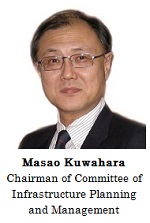 the committee was Masatsugu Suzuki (32nd President of the JSCE). He was awarded Order of Culture first in the civil engineering field in 1968.
the committee was Masatsugu Suzuki (32nd President of the JSCE). He was awarded Order of Culture first in the civil engineering field in 1968.
The aim of the committee is to seek ideal figure of infrastructure planning as well as to solve the issues from the viewpoint of civil engineers. The committee’s tasks include discussions on the basic philosophy, theory and education of infrastructure planning.Moreover, to deliver the importance of infrastructure planning, the committee
hosts symposiums and other events as well as publishes study outcomes. Infrastructure planning and management is the study of the philosophy, methods, procedures, design, and maintenance of infrastructure facilities, such as roads, railways, parks, harbors, and airports, in order to ensure safety and comfort. Recently, this field of study has expanded to encompass sociology and psychology in order to clarify the process of consensus building, which is necessary for developing infrastructure facilities. This reflects civil engineering’s broad foundation as a systemized science.
The committee holds biannual meetings in the spring and autumn to exchange studies on infrastructure planning and management. The participants include not only researchers from universities but also people working in fields related to infrastructure planning and management. The meetings run for two days in the spring and three days in the autumn. The meeting last autumn was the 50th anniversary. The subjects of the presentations are extensive covering planning theory, national land planning, city planning, traffic planning, traffic engineering, safety, disaster recovery, landscaping, civil engineering history, and consensus building. We welcome presentations in English and look forward to contributions from overseas members.
The section in charge of international seminars arranges lectures for overseas researchers and specialists visiting Japan. They also provide assistance to universities, research institutes, and other bodies that hold lecture meetings and other events. Speakers are presented a Certificate of Appreciation by the committee chairman.
The 50th anniversary commemorative seminar has been initiated from the spring meeting in 2014. We plan to hold a ceremony and publish commemorative books in 2016, and look forward to further contributing to society through infrastructure planning and management.
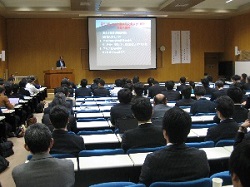 Research Workshop Research Workshop |
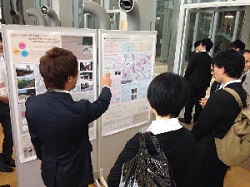 Public Policy Design Competition |
Seminar on Bridge Health Monitoring Held in Vietnam
On March 19 and 20 2014, Seminar on Bridge Health Monitoring (BHM) was held in Ho Chi Minh City, Vietnam, co-hosted by JSCE and Ho Chi Minh City University of Technology (HCMUT).
More than 80 people participated in the morning session on the 19th held at the auditorium of HCMUT. Four topics shown below were presented;
1.Current Status of BHM in Vietnam (Dr. To Nam Toan, Directorate for Roads of Vietnam, Ministry of Transport, Vietnam)
2.Theory and Application of Weigh-In-Motion (WIM) Technology ( Dr. Hisatada Suganuma, TTES Inc., Japan)
3.Fiber Optic Sensors and the application to BHM (Mr. Munenori Tsuchiya, Nagano Keiki Co., Ltd., Japan)
4.System Architecture and Data Application of BHM (Dr. Yuji Ishikawa, NTT Data Corporation, Japan)
This kind of seminar was often conducted in Hanoi, the northern city of Vietnam. This time, however, it was held in HCMC so that the activity in the south can be strengthened. In Vietnam, there are many old bridges that require inspection and maintenance. In addition, many cable-stayed bridges have been constructed recently. Therefore, BHM is becoming more and more important in Vietnam. With this background, there was productive discussion in the Q&A session between the presenters and participants.
In the afternoon, a closed round-table meeting was held attended by key persons. In the meeting, concrete approach for items proposed by each group was discussed and the communication network was confirmed.
On the 20th, Japanese participants visited several bridges in HCMC accompanied by professors of HCMUT.
The Vietnam Group considers that the seminar is the first step for future collaboration between Japan and Vietnam in the area of bridge engineering. Therefore, follow-up activity will be continued for tightening the collaboration, implementation of an actual project and deployment to various places in Vietnam.
|
|
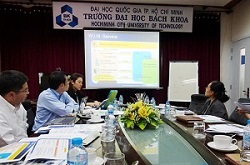 Closed Round-table Meeting |
[Reported by Vietnam Group of International Activity Center, JSCE]
Reference: Takayuki Ishizuka, 'Seminar on Bridge Health Monitoring in Vietnam (in Japanese),' Bridge and Foundation Engineering, Vol. 49, No. 2, pp.83, February 2015.
What's Happening
● 2015/3/16・・・・・・UN World Conference on Disaster Risk Reduction 2015 Sendai, Japan Public Forum “That has been done by the Japanese Civil Engineers since Mar.11, 2011” at Miyagi Pref. Government Office, Sendai, Miyagi http://committees.jsce.or.jp/2011quake/node/174
● 2015/3/23・・・・・・IAC Japanese Civil Engineers the Global Leaders Symposium Series No.4
http://committees.jsce.or.jp/kokusai/node/74 (Japanese only)
● 2015/3/27-28・・・・ACECC 28th Executive Council Meeting (ECM) in Dhaka, Bangladesh
● 2015/4/2・・・・・・JSCE IAC USA Group meeting on ASCE’s Global Engineering 2014 Conference in Panama (Special lecture and DVD on Akira Aoyama included) at JSCE HQ, Tokyo
Registration:http://www.jsce.or.jp/event/active/information.asp
Updates
●The summary of feature articles in the JSCE Magazine is available on the JSCE website.
http://www.jsce-int.org/pub/magazine
●Concrete Committee International Newsletter No.
http://www.jsce.or.jp/committee/concrete/e/newsletter/Newsletter.htm
●Journal of JSCE
The Journal of JSCE is the collection of research papers which can be viewed on the JSCE website.
https://www.jstage.jst.go.jp/browse/journalofjsce
●JSCE 100th Anniversary Postal Stamp was released in September, 2014.
http://jsce100.com/node/250(Japanese Only)
●European Council of Civil Engineers(ECCE)has released the 2nd book in the ECCE Book Project,
”Footbridges-Small is beautiful.” 17 footbridges are contributed from JSCE: http://www.ecceengineers.eu/
●JSCE Korea Section Office is now opens in Gangnam-gu in Seoul. Please stop by if you have chance to come nearby.
<JSCE Korea Section Office>
Mr. Kim, Jae-Kwon, President, JSCE Korea Section
1605 Yeoksam venturetel, 20,Teheran-ro 25-gil, Gangnam-gu, Seoul Korea 135-910
Tel: +82 (0)2-6925-4563 E-mail:jkviva @ gmail.com
IAC News Subscription
The IAC News is one of the communication tools to share information and ideas with the members. We would like to invite you, your friends and colleagues to join the communication and to subscribe the IAC News. Please register online: (http://www.jsce-int.org/pub/registration/non-international_students). We look forward to meeting you.
Editor's postscript
January. and February are not only cold winter season but also entrance examination season in Japan.
People who want to enter the National University have to take “National Center Test for University Admissions” which is usually held in January. Most private universities carry out the entrance examination in February. High school students and high school graduates study hard to prepare the examination. Some people get happy news but some people get sad result. That is LIFE.
I hope many young people apply for civil engineering schools. We are also waiting foreign students who want to study civil engineering at Japanese universities. Please do not hesitate to ask any question to each university.

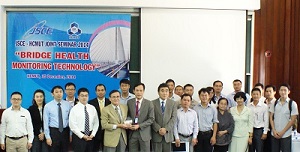 Participants and Faculty of HCMUT
Participants and Faculty of HCMUT